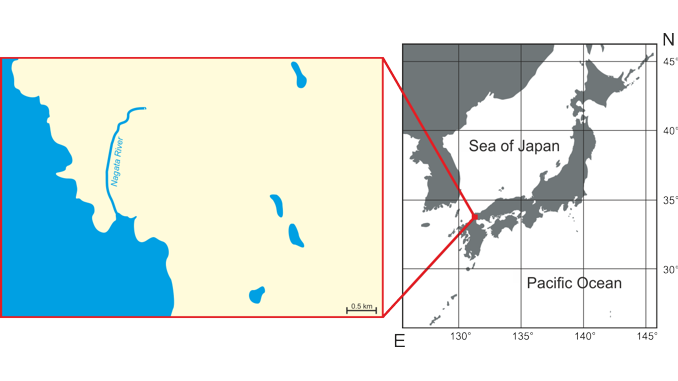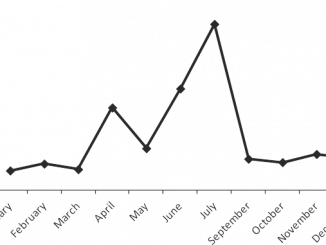
Paper category: Short communication
Corresponding author: Takaomi Arai (takaomi.arai@ubd.edu.bn)
DOI: 10.1515/ohs-2017-0046
Received: February 19, 2017
Accepted: May 15, 2017
Full text: here
Citation (APA style):
Abstract
In order to understand the silver eel migration behavior of the Japanese eel Anguilla japonica, the life history of both the yellow stage (immature stage) and the silver stage (early maturing stage) was examined during the silver eel migration period, using otolith microchemical analysis of strontium (Sr) and calcium (Ca) concentrations. The mean Sr:Ca ratios in A. japonica from the elver mark to the otolith edge indicate eels of several general categories of migratory histories, including sea eels (average Sr:Ca ratios, ≥ 6.0 × 10-3), estuarine eels (average Sr:Ca ratios, 2.0 × 10-3 ≤ Sr:Ca < 6.0 × 10-3) and river eels (average Sr:Ca ratios, < 2.0 × 10-3), based on the criteria reported previously in A. japonica. A significant negative correlation was observed between the gonadosomatic index (GSI) and the mean Sr:Ca ratios during the growth phase after recruitment. Gonads of river eels were more developed compared to eels with other migratory histories. It thus appears that the maturation level for the silver eel migration to the open ocean varies depending on the life history.
References
Arai, T. & Chino, N. (2017). Influence of water salinity on the strontium:calcium ratios in otoliths of the giant mottled eel, Anguilla marmorata. Environmental Biology of Fishes 100(3): 281-286. DOI: 10.1007/s10641-016-0569-7.
Arai, T., Kotake, A., Lokman, P.M., Miller, M.J. & Tsukamoto, K. (2004). Evidence of different habitat use by New Zealand freshwater eels, Anguilla australis and A. dieffenbachii, as revealed by otolith microchemistry. Marine Ecology Progress Series 266: 213-225. DOI: 10.3354/meps266213.
Arai, T., Kotake, A. & McCarthy, T.K. (2006). Habitat use by the European eel Anguilla auguilla in Irish waters. Estuarine, Coastal and Shelf Science 67(4): 569-578. DOI: 10.1016/j.ecss.2006.01.001.
Arai, T., Kotake, A., Ohji, M., Miyazaki, N. & Tsukamoto, K. (2003a). Migratory history and habitat use of Japanese eel Anguilla japonica in the Sanriku Coast of Japan. Fisheries Science 69(4): 813-818. DOI: 10.1046/j.1444-2906.2003.00691.x.
Arai, T., Kotake, A., Ohji, M., Miller, M.J., Tsukamoto, K. et al. (2003b). Occurrence of sea eels of Anguilla japonica along the Sanriku Coast of Japan. Ichthyological Research 50(1):78-81. DOI: 10.1007/s102280300011.
Arai, T., Otake, T. & Tsukamoto, K. (1997). Drastic changes in otolith microstructure and microchemistry accompanying the onset of metamorphosis in the Japanese eel, Anguilla japonica. Marine Ecology Progress Series 161:17-22. DOI: 10.3354/meps161017.
Bertin, L. (1956). Eels – a biological study. London: Cleaver-Hume Press Ltd.
Chino, N. & Arai, T. (2009). Relative contribution of migratory type on the reproduction of migrating silver eels, Anguilla japonica, collected off Shikoku Island, Japan. Marine Biology 156(4): 661-668. DOI: 10.1007/s00227-008-1116-7.
Chino, N. & Arai, T. (2010). Habitat use and habitat transitions in the tropical eel, Anguilla bicolor bicolor. Environmental Biology of Fishes 89(3): 571-578. DOI: 10.1007/s10641-010-9677-y.
Chow, S., Kurogi, H., Mochioka, N., Kaji, S., Okazaki, M. et al. (2009). Discovery of mature freshwater eels in the open ocean. Fisheries Science 75(1): 257-259. DOI: 10.1007/s12562-008-0017-5.
Jellyman, D.J. (1987). Review of the marine life history of Australian temperate species of Anguilla. American Fisheries Society Symposium 1: 276-285.
Kotake, A., Okamura, A., Yamada, Y., Utoh, T., Arai, T. et al. (2005). Seasonal variation in migratory history of the Japanese eel, Anguilla japonica, in Mikawa Bay, Japan. Marine Ecology Progress Series 293: 213-221. DOI: 10.3354/meps293213.
Kotake, A., Arai, T., Okamura, A., Yamada, Y., Utoh, T. et al. (2007). Ecological aspects of Japanese eels, Anguilla japonica, collected from coastal areas of Japan. Zoological Science 24(12): 1213-1221. DOI: 10.2108/zsj.24.1213.
Krueger, W.H. & Oliveira, K. (1997). Sex, size and gonad morphology of silver American eel Anguilla rostrata. Copeia 1997(2): 415-420.
Lamson, H.M., Shiao, J.C., Iizuka, Y., Tzeng, W.N. & Cairns, D.K. (2006). Movement patterns of American eels (Anguilla rostrata) between salt- and freshwater in a coastal watershed, based on otolith microchemistry. Marine Biology 149(6): 1567-1576. DOI: 10.1007/s00227-006-0418-x.
Matsui, I. (1972). Eel biology – biological study. Tokyo: Koseisha-Koseikaku.
McDowall, R.M. (1988). Diadromy in fishes. London: Cromm Helm.
Poole, W.R. & Reynolds, J.D. (1996). Growth rate and age at migration of Anguilla anguilla. Journal of Fish Biology 48(4): 633-642. DOI: 10.1111/j.1095-8649.1996.tb01458.x.
Sasai, S., Aoyama, J., Watanabe, S., Kaneko, T., Miller, MJ. et al. (2001). Occurrence of migrating silver eels, Anguilla japonica, in the East China Sea. Marine Ecology Progress Series 212: 305-310. DOI: 10.3354/meps212305.
Sokal, R.R. & Rohlf, F.J. (1995). Biometry. The principles and practice of statistics in biological research. Third edition. New York: W.H. Freeman.
Sudo, R., Okamura, A., Fukuda, N., Miller M.J. & Tsukamoto, K. (2017) Environmental factors affecting the onset of spawning migrations of Japanese eels (Anguilla japonica) in Mikawa Bay Japan. Environmental Biology of Fishes 100(3): 237-249. DOI: 10.1007/s10641-017-0575-4.
Svendäng, H., Neuman, E. & Wickström, H. (1996) Maturation patterns in female European eel: age and size at the silver eel stage. Journal of Fish Biology 48(3): 342-351. DOI: 10.1111/j.1095-8649.1996.tb01432.x.
Tesch, F.W. (1977). The eel. Biology and management of anguillid eels. London: Chapman and Hall.
Todd, P.R. (1981). Timing and periodicity of migration New Zealand freshwater eels (Anguilla spp.). New Zealand Journal of Marine and Freshwater Research 15(3): 225-235.
Tsukamoto, K. (1992). Discovery of the spawning area for the Japanese eel. Nature 356: 789-791.
Tsukamoto, K. (2009). Oceanic migration and spawning of anguillid eels. Journal of Fish Biology 74(9): 1833-1852. DOI: 10.1111/j.1095-8649.2009.02242.x.
Tsukamoto, K. & Arai, T. (2001). Facultative catadromy of the eel, Anguilla japonica, between freshwater and seawater habitats. Marine Ecology Progress Series 220: 265-276. DOI: 10.3354/meps220265.
Tzeng, W.N. (1996). Effects of salinity and ontogenetic movements on strontium:calcium ratios in the otoliths of the Japanese eel, Anguilla japonica Temminck and Schlegel. Journal of Experimental Marine Biology and Ecology 199(1): 111-122. DOI: 10.1016/0022-0981(95)00185-9.
Utoh, T., Mikawa, N., Okamura, A., Yamada, Y., Tanaka, S. et al. (2004). Ovarian morphology of the Japanese eel in Mikawa Bay. Journal of Fish Biology 64(2): 502-513. DOI: 10.1111/j.0022-1112.2004.00317.x.
Wenner, C.A. & Musick, J.A. (1974). Fecundity and gonad observations of the American eel, Anguilla rostrata, migrating from Chesapeake Bay, Virginia. Journal of the Fisheries Research Board of Canada 31(8):1387-1391.


Bądź pierwszy, który skomentuje ten wpis